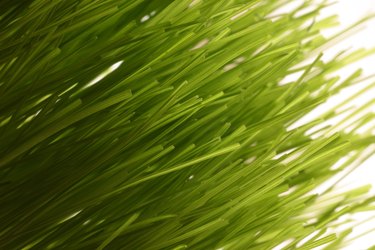
Annual ryegrass can germinate in four to five days, making this an excellent temporary crop for lawns and gardens. To ensure an even distribution of grass seed over the desired surface, use a spreader, such as Scotts Standard Broadcast Spreader. Broadcast spreaders adjust to accommodate for different size contents. Grass seed can be expensive, and you don't want to waste too much by having your spreader set on a high setting.
What is Annual Ryegrass
Video of the Day
As the name denotes, annual ryegrass, or Lolium multiflorum, is a ryegrass that will only last one year, making it a temporary crop. It is a cool-season, bunch grass that grows 3 to 4 feet tall if left unmowed. The base of the plant is yellowish-green, with shiny leaves above. Annual ryegrass forms a dense, mat-forming root mass that makes it a great temporary cover for slopes and embankments.
Video of the Day
Benefits of Annual Ryegrass
The quick germinating rate and solid root mass give this member of the Poa, or grass, family a broad range of uses. For homeowners, annual ryegrass is often found in quick-fix grass seed mixes as a temporary solution to problem spots in their lawns while other seed is getting established. Annual ryegrass is also used as a cover crop, adding biomass and nitrogen to depleated soils. Annual ryegrass is used in rotational grazing systems as a forage crop that is often interplanted with a legume, or nitrogen fixing plant.
Spreading Annual Ryegrass
Spreading annual ryegrass with a broadcast spreader like Scotts Standard model will help to create an evenly germinating patch of grass. Adjust your spreader setting to read 10 for optimum accuracy and coverage. You can seed annual ryegrass over a warm-season grass such as bermudagrass that goes dormant in the winter. The annual rye will keep your lawn looking green all year long. For vegetable gardeners, spread annual ryegrass in the late summer in patches that are harvested, and incorporate back into the soil before the grass blooms.
Tips for Maintaining Annual Ryegrass
Annual ryegrass can tolerate a wide range of soil conditions, but keep in mind that it is a heavy nitrogen feeder. It will not tolerate heavily shaded areas, and prefers a soil with a pH of 5.5 to 7. This encompasses most soils, but areas with extremes in pH may have to amend the soil. Annual ryegrass does well in high elevations with humidity. Optimum growing conditions are during cool months of the year. In the northern U.S., this encompasses spring and fall; in tropical climates, the winter.